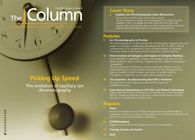Analysis of Wastewater in New York State Indicates Illicit Drug Consumption
The study of sewage using chromatographic techniques is a rapidly expanding area that can provide insights into the consumption of illicit drugs. Measuring illicit drug concentrations can provide authorities with a close to real time identification of consumption trends and rates in specific geographical areas.
The study of sewage using chromatographic techniques is a rapidly expanding area that can provide insights into the consumption of illicit drugs. Measuring illicit drug concentrations can provide authorities with a close to real time identification of consumption trends and rates in specific geographical areas (1).
A team of scientists recently performed liquid chromatography–electrospray tandem mass spectrometry (LC–ESI–MS–MS) to determine illicit drug use in New York State (2). In this study, 24-hr composite wastewater influent, primary effluent, final effluent and sludge samples were collected daily for seven days from two wastewater treatment plants (WWTPs) in New York State and analyzed for the presence of selected illicit drugs (six drugs and eight metabolites). The concentration of illicit drugs determined in sewage sludge and wastewater effluent was used to calculate the total environmental emission from the WWTPs. Other markers such as caffeine, paraxanthin, nicotine and cotinine were used to predict the concentration of selected illicit drugs in wastewater.
The environmental emission of illicit drugs per capita from discharges from WWTPs was calculated to range from 0.38 mg/d/1000 people (MDEA) to 67.5 mg/d/1000 (EDDP). The emission rates for BEG, MAPT, MTD, MPH, MDMA ranged from 10.5 mg/d/1000 people to 20.5 mg/d/1000 people. MDA was the most abundant hallucinogen found in wastewater effluent at a mean concentration of 304 ng/L.
Co-author of the study, Bikram Subedi, postdoc research affiliate at Wadsworth Centre (Albany, New York) told LCGC: “Further research should involve investigating the stability of illicit drugs in wastewater matrices and also a comprehensive evaluation of their discharge to the receiving environment including agricultural land, surface water, and drinking water. The evaluation of the potential environmental health effects as a result of prolonged exposure to these contaminants is important.”
A similar study set up in Europe published recently revealed the findings of drug consumption trends in 42 European cities using liquid chromatography tandem mass spectrometry (LC–MS–MS) (1).
References
1. C. Ort et al. Addiction, DOI:10.1111/add.12570 (2014).
2. B. Subedi and K. Kurunthachalam, Environmental Science and Technology, DOI: 10.1021/es501709a (2014).
This story originally appeared in The Column. Click here to view that issue.

University of Rouen-Normandy Scientists Explore Eco-Friendly Sampling Approach for GC-HRMS
April 17th 2025Root exudates—substances secreted by living plant roots—are challenging to sample, as they are typically extracted using artificial devices and can vary widely in both quantity and composition across plant species.
Thermodynamic Insights into Organic Solvent Extraction for Chemical Analysis of Medical Devices
April 16th 2025A new study, published by a researcher from Chemical Characterization Solutions in Minnesota, explored a new approach for sample preparation for the chemical characterization of medical devices.










